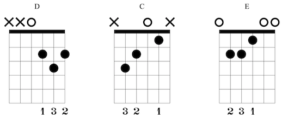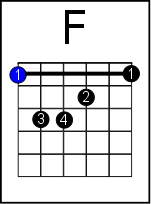Understanding how to read the basics of music notation is an essential tool to use when learning any new instrument, or to continue to learn your new favorite songs for years to come. Whether it is a chord chart, Tablature, or standard sheet music, the idea is the same – to write down the notes that are played on your instrument. Chord charts are very simple, and won’t take too much time to fully understand. So let’s take a look at what a chord chart looks like.


Chord charts are an exact representation of the fretboard of the guitar.
• Going vertically from right to left, you have 6 lines. Each line represents each of the 6 guitar strings. String 1 being on the far right, and string 6 being on the far left.
• The thick bold line on the top is representing the nut.
• A standard chord chart has 4 or 5 horizontal lines going across. These are representing the frets.
Here is an example of a blank chord chart :
Chords are a combination of 2 or more notes played at the same time. There are many different types of chords, and all of them can be notated by a chord chart. Here is what they look like, and how to read it :
• Black dots indicate what string and fret to place a finger.
• Numbers underneath indicate which finger on your left hand to use.
Index – 1 Middle – 2 Ring – 3 Pinky – 4
-
“X” indicates to not play those strings when you strum.
-
“O” refers to strum that string “open”, so strum it with
no fingers pressed on any frets.
• The letter on top of the chart tells you the name of the chord. The letter is the root note of the chord. A lower case “m” next to it would indicate that the chord is minor.
• The bold black lines indicates a “barre” meaning you use 1 finger to play multiple notes.
and that’s it! Simple, right?
